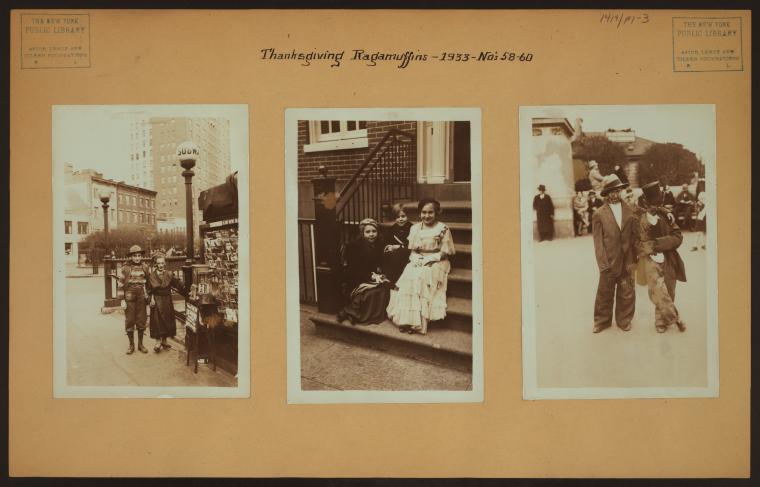Trick-or-Treating… But on Thanksgiving?

Tonight is Halloween, and throughout many parts of the world, children (and some adults) will dress in costumes and take to the streets demanding candy from the people in their neighborhoods. And, by and large, their neighbors will gladly provide that demanded candy, and with a smile. It’s a really nice moment for kids and communities to come together and celebrate, and it’s unsurprising that the tradition has become popular.
But “trick-or-treating,” as the act of asking for candy is now known, didn’t always happen on Halloween. During the late 19th and into the mid-20th century, in New York City, kids dressed up and went door-to-door looking for treats much like they do today. But it took place about four weeks from now, on Thanksgiving.
In 1863, Abraham Lincoln declared Thanksgiving a national holiday in the United States. With the day off from school — and in an era before helicopter parenting was the norm — children were free to do whatever they wished. And in NYC, starting in the early 1870s, some kids decided it’d be fun to pretend to be beggars for a day. They’d dress up in shabby, often oversized clothes, as seen in the photo above (via the New York Public Library’s collection; a larger version of the image can be seen here). And then they’d take to the streets and torment everyone else. At first, it was only a handful of children who participated in what could only be described as mischief, but over the years, the trend grew. It became known as “Ragamuffin Day” — a “ragamuffin” being a “poorly clothed [and] often dirty child” per Merriam-Webster — and over time, the ragamuffins took over the city. Atlas Obscura, citing a newspaper article from 1911, explains:
Unsupervised and unfettered by work or school, New York’s children had a rare opportunity to cut loose. [ . . . ] [The article] describes thousands upon thousands of these “ragamuffins” wreaking havoc by pelting pedestrians with confetti and flour, hitching rides on the fenders of moving cars, blasting horns, riding horses, and finding all sorts of ways to “generally enjoy themselves to the limit of their temporary freedom.” Life as a kid around the turn of the 20th century wasn’t great—around 6 percent of the workforce in 1900 was under 16—particularly in New York’s crumbling tenement buildings. But for one day of pure mayhem, children could get away with just about everything “short of the actual commission of crime.”
And with the mayhem came increasingly creative disguises. Starting before the turn of the century, Thanksgiving became synonymous with masquerading. NPR, citing a newspaper article from 1897, notes that “Thanksgiving was ‘the busiest time of the year for the manufacturers of and dealers in masks and false faces. The fantastical costume parades and the old custom of making and dressing up for amusement on Thanksgiving day keep up from year to year in many parts of the country, so that the quantity of false faces sold at this season is enormous.”
But many in power never accepted the Ragamuffin Day activities, and in the 1930s, the tradition began to wane. For example, NPR, in the 1930s, “School Superintendent William J. O’Shea instructed administrators that ‘modernity is incompatible with the custom of children to masquerade and annoy adults on Thanksgiving day’ by asking for gifts and money.” Other organizations frowned upon children poking fun at the destitute, particularly as the Great Depression put many out of work. By the end of the decade, Ragamuffin Day was barely celebrated, turning into nothing more than a series of sparsely attended parades.
It didn’t matter to the kids, though. At around the time Ragamuffin Day fell to the cultural wayside, a new tradition was emerging — Halloween. Because the costumes-and-candy aspects were so similar, most of the few remaining ragamuffin parades shifted from Thanksgiving to October 31st or thereabouts. (Pleasantville, NY, and Hoboken, NJ — both New York City suburbs — planned parades for yesterday and today, respectively.) Ultimately, the change was a win-win: kids still got to trick or treat, and the adults didn’t have to worry about being pestered on Thanksgiving.
Bonus fact: It’s not quite clear where the first all-town Halloween party happened, but Anoka, Minnesota lays claim to that honor — and the United States Congress agrees, maybe. According to the Minneapolis Post, Anoka — a suburb of Minneapolis/St. Paul — “was the first U.S. city to put on a Halloween celebration, which began in 1920 to divert kids from doing Halloween pranks.” The festivities became incredibly popular in the region and in 1937, according to Mental Floss, “12-year-old Anoka local Harold Blair was one of 200 Minneapolis Journal newspaper carriers to receive an all-expenses-paid trip to Washington, D.C. Members of the Anoka Commercial Club seized on the opportunity, sending Blair off with a request to Congress that Anoka be formally designated as the ‘Halloween Capital of the World.'” Anoka officials claim that Blair was successful in his efforts and that Congress did, in fact, give him something official-looking that made such a designation, but no such evidence exists; as Smithsonian notes, “unfortunately, a fire in Anoka destroyed many of Anoka’s earliest documents about Halloween, so there’s no paper trail proving whether or not Congress confirmed the proclamation.” So perhaps Anoka’s treat is really a trick?
From the Archives: Where Did the Fear of Poisoned Halloween Candy Come From?: It’s mostly a myth.
